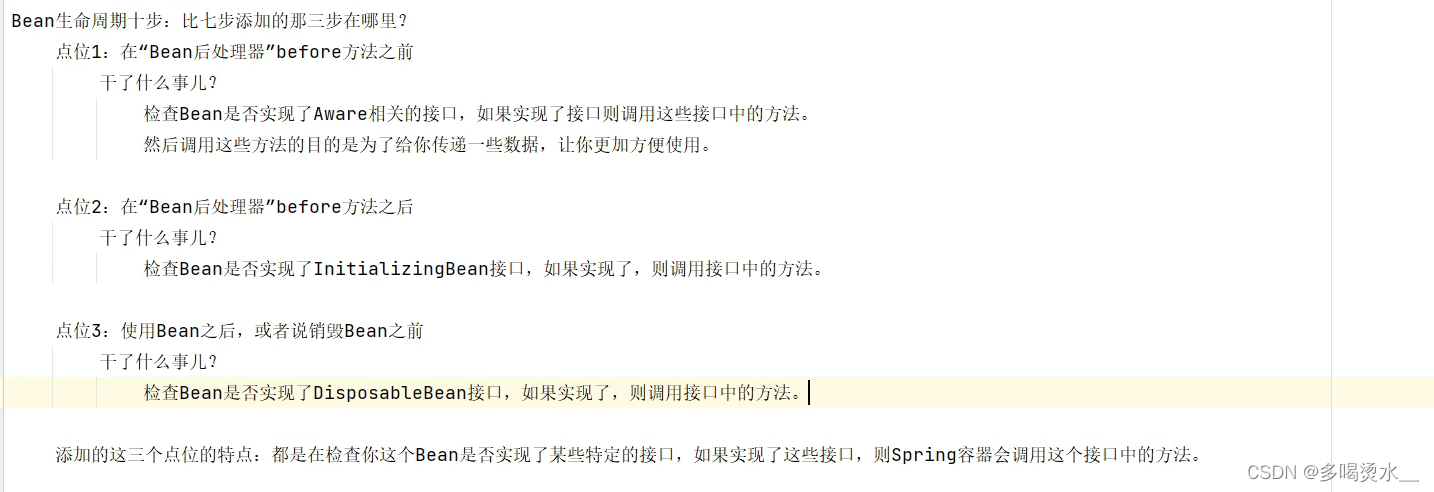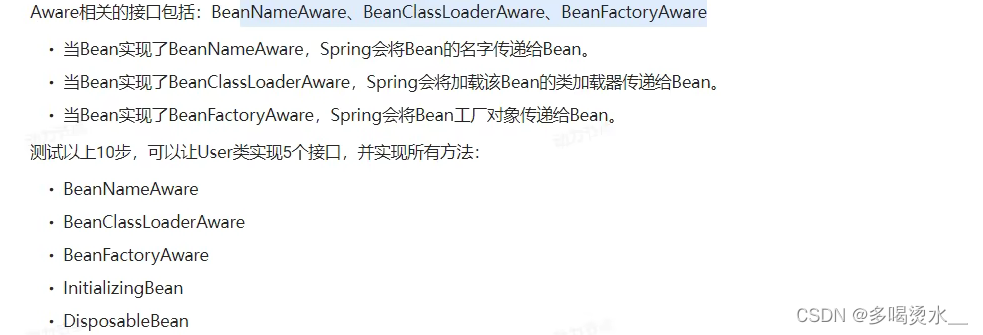一、bean的作用域
单例

默认化为:单例(singleton)
SpringBean类:
java
package com.hei.bean;
public class SpringBean {
public SpringBean(){
System.out.println("Springbean的无参数构造方法执行了");
}
}spring,xml:
XML
<bean id="sb" class="com.hei.bean.SpringBean"></bean>测试类:
java
public class Test {
@org.junit.Test
public void Test() {
ApplicationContext applicationContext=new ClassPathXmlApplicationContext("spring.xml");
SpringBean s1= applicationContext.getBean("sb", SpringBean.class);
System.out.println(s1);
SpringBean s2= applicationContext.getBean("sb", SpringBean.class);
System.out.println(s2);
SpringBean s3= applicationContext.getBean("sb", SpringBean.class);
System.out.println(s3);
}
}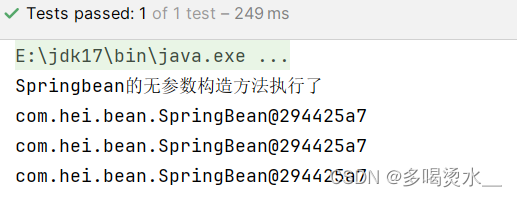
多例
可以手动的调用多例对象(prototype),在xml中利用 scope:
spring.xml:
XML
<bean id="sb" class="com.hei.bean.SpringBean" scope="prototype"></bean>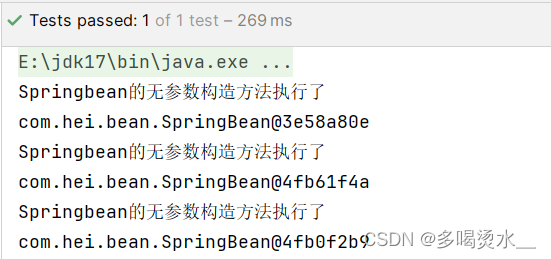
scope

工厂模式的三种形态

简单工厂模式
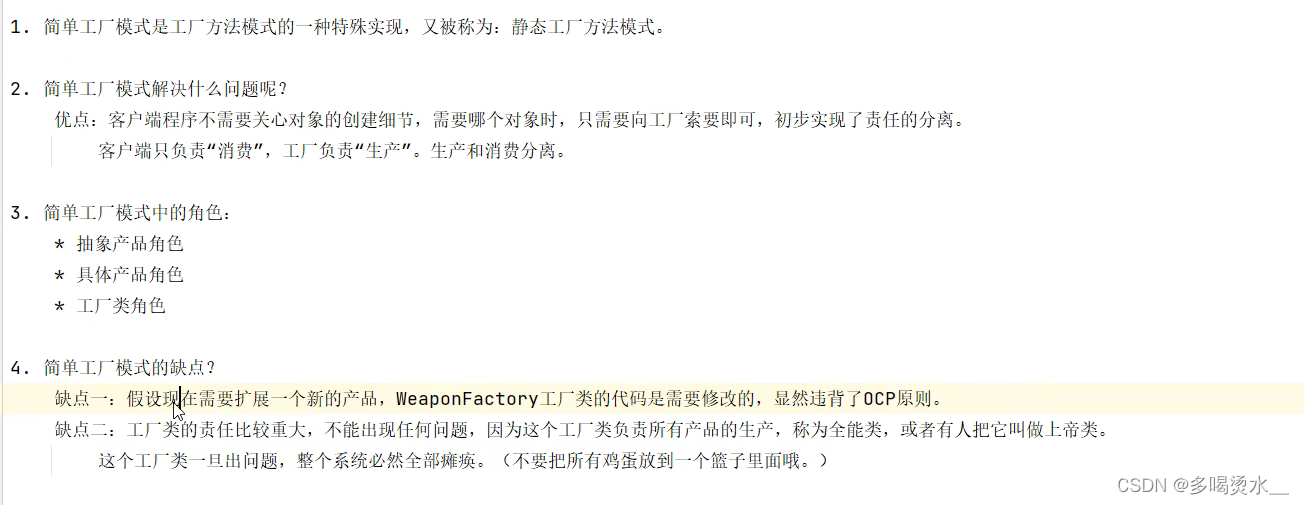 抽象产品类:
抽象产品类:
java
package test1;
public abstract class Weapon {//抽象类
public abstract void attack();
}具体产品类:
java
package test1;
public class Tank extends Weapon{//具体类
@Override
public void attack(){
System.out.println("坦克准备起步...");
}
}
package test1;
public class Figter extends Weapon{//具体类
@Override
public void attack(){
System.out.println("战斗机准备起飞...");
}
}
package test1;
public class Dagg extends Weapon{//具体类
@Override
public void attack(){
System.out.println("某某某正在砍敌人");
}
}工厂类:
java
package test1;
public class WeaponFactory {//工厂类
//静态方法:要获取什么产品,就看你传的什么参数
//简单工厂模式中有一个静态方法,被称为静态工厂方法模式
public static Weapon Get(String type){
if("Tank".equals(type)){
return new Tank();
}else if("Figter".equals(type)){
return new Figter();
}else if("Dagg".equals(type)){
return new Dagg();
}
return null;
}
}测试类:
java
public class test1 {
public static void main(String[] args) {
Weapon t= WeaponFactory.Get("Tank");
t.attack();
Weapon f= WeaponFactory.Get("Figter");
f.attack();
Weapon d= WeaponFactory.Get("Dagg");
d.attack();
}
}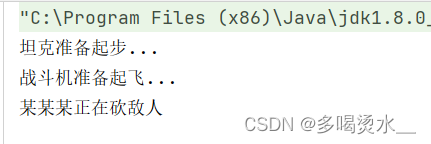
工厂方法模式
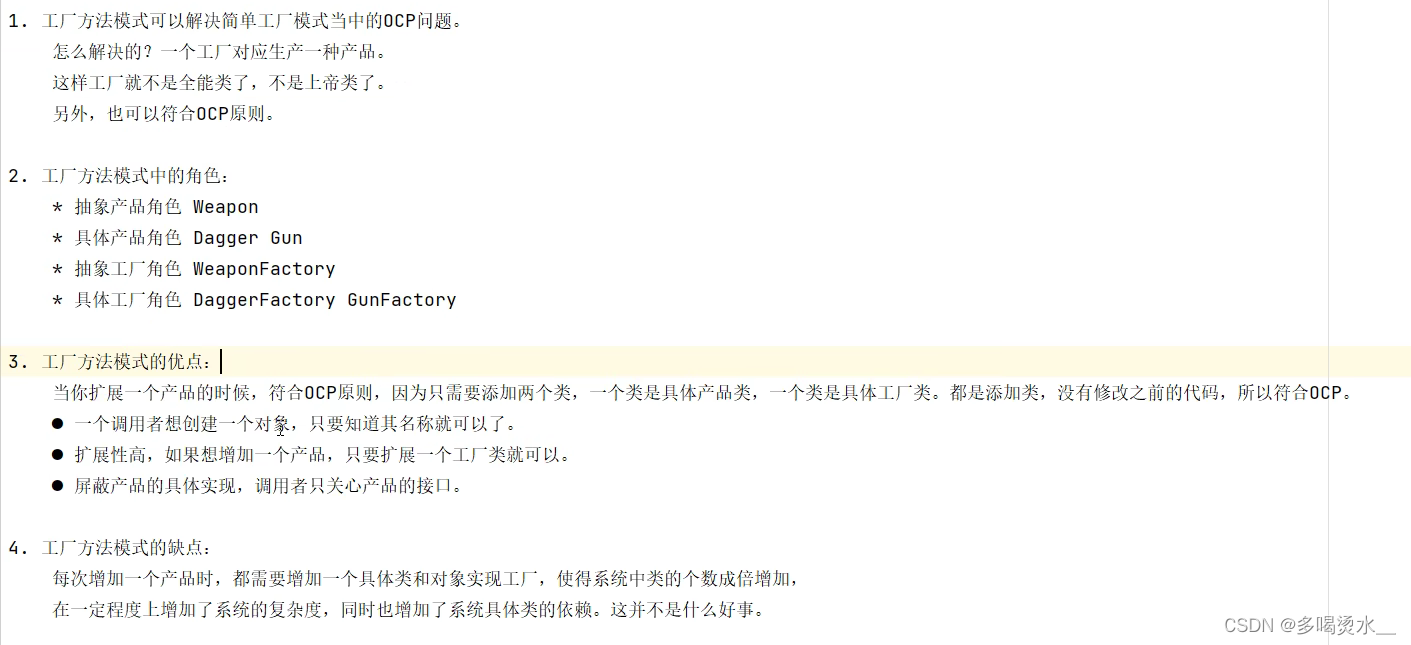
抽象产品:
java
package test1;
public abstract class Weapon {//抽象类
public abstract void attack();
}具体产品:
java
package test1;
public class Tank extends Weapon{//具体类
@Override
public void attack(){
System.out.println("坦克准备起步...");
}
}
package test1;
public class Dagg extends Weapon{//具体类
@Override
public void attack(){
System.out.println("某某某正在砍敌人");
}
}抽象工厂:
java
package test1;
public abstract class WeaponFactory {//抽象工厂
public abstract Weapon Get();
}具体工厂:
java
package test1;
public class TankFactory extends WeaponFactory{
@Override
public Weapon Get() {
return new Tank();
}
}
package test1;
public class DaggFactory extends WeaponFactory{
@Override
public Weapon Get() {
return new Dagg();
}
}测试类:
java
public class test1 {
public static void main(String[] args) {
WeaponFactory weaponFactory=new TankFactory();
Weapon tank=weaponFactory.Get();
tank.attack();
WeaponFactory weaponFactory1=new DaggFactory();
Weapon dagg=weaponFactory1.Get();
dagg.attack();
}
}
Bean的实例化方法
1.通过构造方法实例化
在配置文件(spring.xml)中,进行bean的实例化。
SpringBean类:
java
package com.hei.bean;
public class SpringBean {
public SpringBean(){
System.out.println("Springbean的无参数构造方法执行了");
}
}spring.xml:
XML
<bean id="sb" class="com.hei.bean.SpringBean"></bean>测试类:
java
public class Test {
@org.junit.Test
public void Test() {
ApplicationContext applicationContext=new ClassPathXmlApplicationContext("spring.xml");
SpringBean s1= applicationContext.getBean("sb", SpringBean.class);
System.out.println(s1);
}
}
2.通过简单工厂模式实例化
产品类:
java
package com.hei.bean;
public class Star {
public Star(){
System.out.println("Star的无参构造方法");
}
}工厂类:
java
package com.hei.bean;
public class StarFacroty {
public static Star get(){
return new Star();
}
}spring.xml中:
XML
<!-- 在Spring配置文件中告诉Spring框架,调用哪个类哪个方法创建bean-->
<bean id="star" class="com.hei.bean.StarFacroty" factory-method="get"></bean>测试类:
java
public class Test {
@org.junit.Test
public void Test() {
ApplicationContext applicationContext=new ClassPathXmlApplicationContext("spring.xml");
Star s= applicationContext.getBean("star", Star.class);
System.out.println(s);
}
}
3.通过factory-bean实例化(工厂方法模式)
具体产品类:
java
package com.hei.bean;
public class Gun {//具体产品
public Gun(){
System.out.println("Gun的无参数构造方法");
}
}具体工厂类:
java
package com.hei.bean;
public class GunFactory {//具体工厂
public Gun get(){
return new Gun();
}
}spring.xml:
XML
<!--通过工厂方法模型,结合factory-bean+factory-method-->
<bean id="gunfactory" class="com.hei.bean.GunFactory"></bean>
<!-- factory-bean告诉Spring调用哪个对象,factory-method告诉Spring调用该对象的哪个方法-->
<bean id="gun" factory-bean="gunfactory" factory-method="get"></bean>测试类:
java
public class Test {
@org.junit.Test
public void Test() {
ApplicationContext applicationContext=new ClassPathXmlApplicationContext("spring.xml");
Gun g = applicationContext.getBean("gun", Gun.class);
System.out.println(g);
}
}
4.通过FactoryBean接口实例化

对第三种方式的一种简化:
Person类:
java
package com.hei.bean;
public class Person {
public Person(){
System.out.println("Person的无参构造");
}
}PersonFactoryBean类:
java
package com.hei.bean;
import org.springframework.beans.factory.FactoryBean;
public class PersonFactoryBean implements FactoryBean<Person> {
@Override
//最主要的方法
public Person getObject() throws Exception {
return new Person();
}
@Override
public Class<?> getObjectType() {
return null;
}
//判断是不是为单例
@Override
public boolean isSingleton() {
return true;
}
}spring.xml:
XML
<!--是第三种方式的简化-->
<bean id="person" class="com.hei.bean.PersonFactoryBean"></bean>测试类:
java
public class Test {
@org.junit.Test
public void Test() {
ApplicationContext applicationContext=new ClassPathXmlApplicationContext("spring.xml");
Person p = applicationContext.getBean("person", Person.class);
System.out.println(p);
}
}
BeanFactory和FactoryBean区别
 FactoryBean实际应用注入Date
FactoryBean实际应用注入Date
student类:
定义一个Date类型的日期,通过set方法赋值。
java
package com.hei.bean;
import java.util.Date;
public class Student {
private Date brith;
public void setBrith(Date brith) {
this.brith = brith;
}
@Override
public String toString() {
return "Student{" +
"brith=" + brith +
'}';
}
}StudentFactoryBean类:
要设置一个日期,需要在程序中传一个字符串(代表日期)
java
package com.hei.bean;
import org.springframework.beans.factory.FactoryBean;
import java.text.SimpleDateFormat;
import java.util.Date;
public class StudentFactoryBean implements FactoryBean<Date> {
private String strdate;
public StudentFactoryBean(String strdate) {
this.strdate = strdate;
}
@Override
public Date getObject() throws Exception {
//创建日期
SimpleDateFormat s=new SimpleDateFormat("yyyy-MM-dd");
Date date=s.parse(strdate);
return date;
}
@Override
public Class<?> getObjectType() {
return null;
}
@Override
public boolean isSingleton() {
return true;
}
}spring.xml:
XML
<bean id="date" class="com.hei.bean.StudentFactoryBean">
<constructor-arg index="0" value="2003-12-15"></constructor-arg>
</bean>
<bean id="student" class="com.hei.bean.Student">
<property name="brith" ref="date"></property>
</bean>测试类:
java
package com.hei;
import com.hei.bean.*;
import org.springframework.context.ApplicationContext;
import org.springframework.context.support.ClassPathXmlApplicationContext;
public class Test {
@org.junit.Test
public void Test() {
ApplicationContext applicationContext=new ClassPathXmlApplicationContext("spring.xml");
Student s = applicationContext.getBean("student",Student.class);
System.out.println(s);
}
}
Bean的生命周期

Bean的生命周期之五步
第一步:实例化Bean是调用此方法的无参构造。
第二步:Bean属性赋值,调用Set方法进行。
第三步:初始化Bean,在类中自己定义一个初始化方法。
第四步:使用Bean,要在spring.xml配置文件中,手动指定初始化方法名和销毁方法名,还需给属性赋值。
第五步:销毁Bean, 在类中自己定义一个销毁方法。
注:在测试类中,要想销毁Bean需关闭spring容器,applicationContext是一个抽象类,需要转换类型为ClassPathXmlApplicationContext.
User类:
java
package com.hei.bean;
public class User {
private String name;
public User() {
System.out.println("第一步 无参数构造方法执行");
}
public void setName(String name) {
System.out.println("第二步 给bean属性赋值");
this.name = name;
}
public void InitaBean(){
System.out.println("第三步 初始化bean");
}
public void destoryBean(){
System.out.println("第五步 销毁bean");
}
}spring.xml:
XML
<!--需要手动指定初始化方法和销毁方法-->
<bean id="Bean" class="com.hei.bean.User" init-method="InitaBean" destroy-method="destoryBean">
<property name="name" value="zhangsan"></property>
</bean>测试类:
java
public class Test {
@org.junit.Test
public void Test() {
ApplicationContext applicationContext=new ClassPathXmlApplicationContext("spring.xml");
User user= applicationContext.getBean("Bean",User.class);
System.out.println("第四步 使用bean "+user);
//使用完了之后要销毁bean,需关闭Spring容器
ClassPathXmlApplicationContext context = (ClassPathXmlApplicationContext) applicationContext;
context.close();
}
}
Bean的生命周期之七步

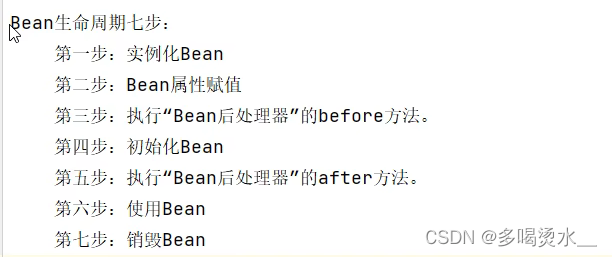
User类:
java
package com.hei.bean;
public class User {
private String name;
public User() {
System.out.println("第一步 无参数构造方法执行");
}
public void setName(String name) {
System.out.println("第二步 给bean属性赋值");
this.name = name;
}
public void InitaBean(){
System.out.println("第三步 初始化bean");
}
public void destoryBean(){
System.out.println("第五步 销毁bean");
}
}Bean后处理器:BeanPost类:
java
package com.hei.bean;
import org.springframework.beans.BeansException;
import org.springframework.beans.factory.config.BeanPostProcessor;
public class Beanpost implements BeanPostProcessor {
@Override
public Object postProcessBeforeInitialization(Object bean, String beanName) throws BeansException {
System.out.println("执行Bean后处理器的before方法");
return BeanPostProcessor.super.postProcessBeforeInitialization(bean, beanName);
}
@Override
public Object postProcessAfterInitialization(Object bean, String beanName) throws BeansException {
System.out.println("执行Bean后处理器的after方法");
return BeanPostProcessor.super.postProcessAfterInitialization(bean, beanName);
}
}spring.xml:
XML
<!--配置Bean后处理器-->
<!-- Bean后处理器将作用于当前配置文件所有的bean-->
<bean class="com.hei.bean.Beanpost"></bean>
<!--需要手动指定初始化方法和销毁方法-->
<bean id="Bean" class="com.hei.bean.User" init-method="InitaBean" destroy-method="destoryBean">
<property name="name" value="zhangsan"></property>
</bean>测试类:
java
public class Test {
@org.junit.Test
public void Test() {
ApplicationContext applicationContext=new ClassPathXmlApplicationContext("spring.xml");
User user= applicationContext.getBean("Bean",User.class);
System.out.println("第四步 使用bean "+user);
//使用完了之后要销毁bean,需关闭Spring容器
ClassPathXmlApplicationContext context = (ClassPathXmlApplicationContext) applicationContext;
context.close();
}
}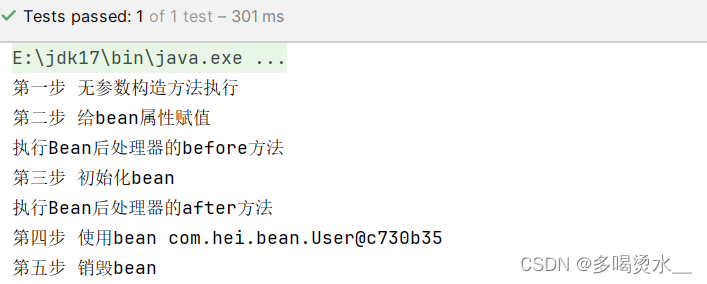
Bean的生命周期之十步
User类:
java
package com.hei.bean;
import org.springframework.beans.BeansException;
import org.springframework.beans.factory.*;
public class User implements BeanNameAware, BeanClassLoaderAware, BeanFactoryAware, InitializingBean, DisposableBean {
private String name;
public User() {
System.out.println("第一步 无参数构造方法执行");
}
public void setName(String name) {
System.out.println("第二步 给bean属性赋值");
this.name = name;
}
public void InitaBean(){
System.out.println("第四步 初始化bean");
}
public void destoryBean(){
System.out.println("第七步 销毁bean");
}
@Override
public void setBeanClassLoader(ClassLoader classLoader) {
System.out.println("Bean这个类的加载器:"+classLoader);
}
@Override
public void setBeanFactory(BeanFactory beanFactory) throws BeansException {
System.out.println("生产这个Bean的工厂:"+beanFactory);
}
@Override
public void setBeanName(String s) {
System.out.println("这个Bean的名字:"+s);
}
@Override
public void destroy() throws Exception {
System.out.println("DisposableBean's destory的方法执行");
}
@Override
public void afterPropertiesSet() throws Exception {
System.out.println("InitializingBean's afterPropertiesSet的方法执行");
}
}只需在User类中添加多个接口,其他类和配置文件不变。
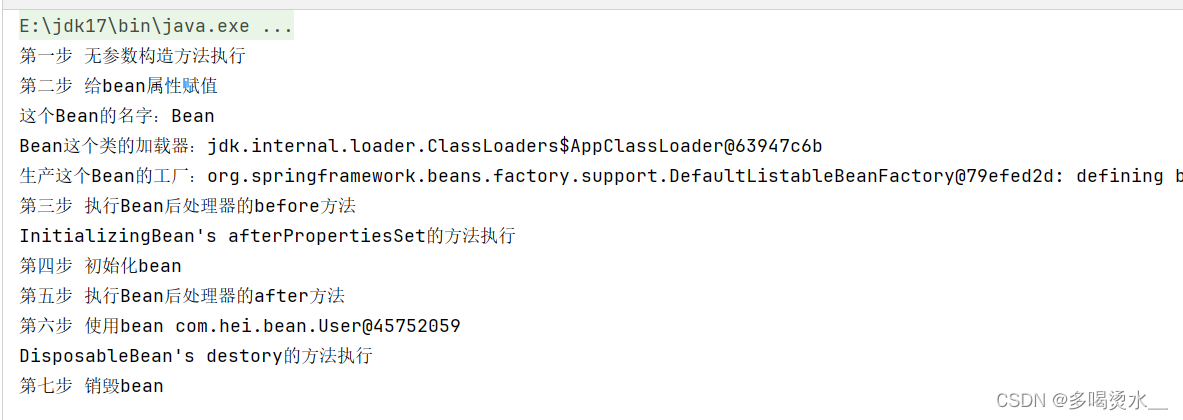
Bean生命周期不同作用域
spring容器只对singleton(单例)的Bean进行完整的生命周期管理。
如果是prototype(多例)作用域的Bean,Spring容器只负责将该Bean初始化完毕,等客户端程序一旦获取到该Bean之后,到使用Bean之后,Spring容器就不再管理该对象的生命周期了。
自己new的对象纳入Spring容器管理
Student类:
java
package com.hei.bean;
public class Student {
}测试类:
java
public class Test {
@org.junit.Test
public void test() {
Student s = new Student();
System.out.println(s);
//将new的对象交给spring容器管理
DefaultListableBeanFactory d = new DefaultListableBeanFactory();
d.registerSingleton("student", s);
//从spring容器中获取
Object S= d.getBean("student");
System.out.println(S);
}
}
Bean的循环依赖
循环依赖:

单例和set模式下的循环依赖
 husband类:
husband类:
java
package com.hei.bean;
public class Husband {
private String name;
private Wife wife;
public void setName(String name) {
this.name = name;
}
public String getName() {
return name;
}
public void setWife(Wife wife) {
this.wife = wife;
}
@Override
public String toString() {
return "Husband{" +
"name='" + name + '\'' +
", wife=" + wife.getName() +
'}';
}
}wife类:
java
package com.hei.bean;
public class Wife {
private String name;
private Husband husband;
public void setName(String name) {
this.name = name;
}
public void setHusband(Husband husband) {
this.husband = husband;
}
public String getName() {
return name;
}
@Override
public String toString() {
return "Wife{" +
"name='" + name + '\'' +
", husband=" + husband.getName() +
'}';
}
}spring.xml:
XML
<bean id="hus" class="com.hei.bean.Husband" scope="singleton">
<property name="name" value="张三"/>
<property name="wife" ref="wife"></property>
</bean>
<bean id="wife" class="com.hei.bean.Wife" scope="singleton">
<property name="name" value="小花"/>
<property name="husband" ref="hus"></property>
</bean>测试类:
java
public class Test {
@org.junit.Test
public void test(){
ApplicationContext applicationContext=new ClassPathXmlApplicationContext("spring.xml");
Wife w= applicationContext.getBean("wife",Wife.class);
System.out.println(w);
Husband h= applicationContext.getBean("hus",Husband.class);
System.out.println(h);
}
}
多例和set模式下的循环依赖
当两个bean的scope都是prototype(多例)会出现异常,若其中一个为singleton(单例)就不会出现异常。


